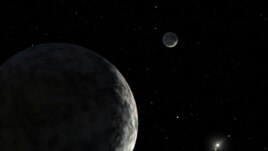19 November 2023
Eris, a very small planet similar in size to Pluto, has remained a mystery since its discovery in 2005. The American spacy agency, NASA, explored Pluto in 2015 using its spacecraft New Horizons. Eris - about 40 percent farther from the sun - has never been visited.
But scientists are gaining a fuller understanding of Eris and its differences with Pluto. A recent study provides details about the little planet's structure and composition based on its relationship with its moon Dysnomia.
Eris, researchers said recently, appears to have a rocky inside under a level of ice. Pluto also has an icy outside with rock below, but has a higher ice content and is thought to have an underground liquid ocean.

FILE - An artist's concept of the dwarf planet Eris and its moon Dysnomia is seen in this undated illustration released by NASA. The sun is the small star in the distance. (NASA/JPL-Caltech/Handout via REUTERS)
"We already knew that Eris is more rock-rich than Pluto, but what we didn't know was whether Eris had separated the rock from the ice," said study lead writer Francis Nimmo of the University of California Santa Cruz. The study appeared in the publication Science Advances.
Nimmo said Eris got hot enough at some point in history to melt, and all the rock sank to the center.
"The ice is not motionless but is experiencing a slow churning motion, driven by leftover heat from the inside. Most likely there is no liquid ocean inside Eris," Nimmo said.
Eris has a diameter of about 2,326 kilometers. Pluto's is a little bigger at about 2,370 km. Both are smaller than the Earth's moon, which has a diameter of 3,475 kilometers. Because of the greater amount of rock, which is denser than ice, Eris has about 25 percent more mass than Pluto.
"As I like to think of it, take Pluto and add every single asteroid in the asteroid belt, and you get Eris," said study co-writer Mike Brown, one of the three scientists who discovered Eris.
Eris orbits at an average of about 68 times further from the sun than Earth. It completes a full turn around the sun in 557 years.
The moon, Dysnomia, is about 700 kilometers in diameter and made up mostly of ice.
"Just like the Earth-moon system, tides on Eris slowly push Dysnomia away and slow down the spin of Eris. This process has gone to completion: Eris and Dysnomia always present the same face to the other," Nimmo said.
Pluto has this same system with its moon Charon, while the Earth-moon system differs.
"The moon always presents the same face to the Earth, but the Earth does not return the favor," Nimmo said.
Eris and Pluto are located beyond Neptune, the outermost of our solar system's eight bigger planets. The International Astronomical Union, which sets definitions for planetary science, recognizes five very small planets known as dwarf planets - Ceres, Haumea and Makemake, in addition to Eris and Pluto. Eris is the most massive of them.
The new findings fill in some questions about Eris.
"Each of the largest dwarf planets is unique and we should be cautious about inferring too much from what we know about Pluto," Brown said.
I'm John Russell.
Will Dunham reported on this story for Reuters. John Russell adapted it for VOA Learning English.
_______________________________________________
Words in This Story
churn – v. to stir or mix something (such as water or mud) with force
diameter – n. the length of a straight line passing through the center of a figure or body
tide – n. the regular upward and downward movement of the level of the ocean
spin – n. to turn or cause to turn round and round